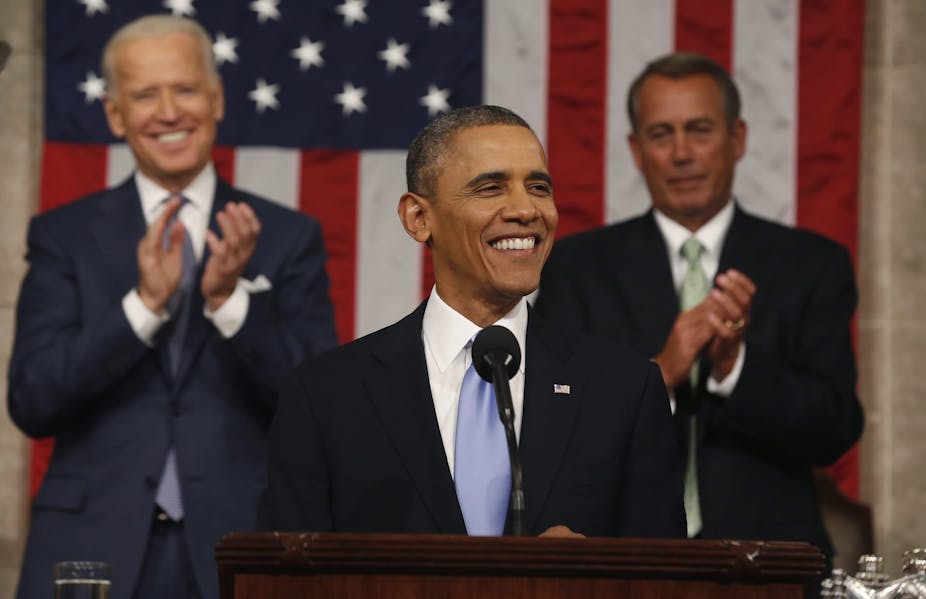Barack Obama may have delivered the annual State of the Union speech before Congress, but his real audience was the Democratic base that his administration needs to mobilise before this November’s midterm elections.
Under no illusions that the gridlocked legislature will pass any major proposal he offers, Obama delivered a more frank address about partisan divisions than Americans have been used to hearing at the State of the Union.
After an anodyne opening lifted directly from General Electric’s “Somewhere in America” advertisements of the last century, Obama went right after intransigent Congressional Republicans from preventing the federal government from “carrying out the most basic functions of our democracy” by repeated shutdowns, filibusters, 40+ symbolic votes to repeal health-care reform, and threats over the debt ceiling, due to be reached again in just one month’s time.
Obama declared “climate change is a fact, the debate is settled”. He vowed to use executive actions whenever he could constitutionally do so, beginning with raising the minimum wage for federal contractors and creating a new MyRA government savings bond to provide a “risk-free” alternative to disappearing employer pension schemes.
The speech was striking for what was not in it. There were no mea culpas for the botched healthcare.gov site roll-out that sank his approval ratings, while mention of his signature accomplishment and the millions who now have insurance came near the end of the speech.
There was barely a mention of the electronic surveillance controversies that have led to criticisms from left, right, and overseas.
One theme the White House hoped to promote was that government programs can make a difference in bettering people’s lives, and that Democrats would no longer go along quiescently with Ronald Reagan’s assertion that government is the problem. If Capitol Hill was dysfunctional, Obama could and did point to local government initiatives or successful implementation at the state level of federal programs such as his Affordable Care Act.
It was no coincidence that Obama brought in the Democratic governor of Kentucky to highlight the success of health-care enrolments. Kentucky’s Republican Senator Mitch McConnell, the minority leader and individual most responsible for stymying the law’s passage, is facing a tough re-election fight and doubtless did not appreciate the attention to his conservative home state where “Obamacare” is now quite popular.
Former president George W. Bush was accused by progressive activists of “dog-whistle politics” for allegedly lacing speeches with hidden references designed to stoke Christian conservatives. Obama seemingly followed a similar plan with this address.
Obama discussed the need to ensure every American has the right to vote, a reference to proposals now before Congress to overhaul the 1960s-era Voting Rights Act, but also a cause célèbre currently among progressive activists enraged at Republican efforts to restrict student and minority voting at the state level. He used a variation of his “Yes we can!” campaign refrain in relation to tackling climate change.
And Obama repeatedly touched on the progressive meme of “the war on women” by references to issues such as pay inequality ratios and higher insurance premiums charged to women for common medical procedures, which he took credit for outlawing. Democratic office holders have recently begun to refer to a war on women as well, and they have been aided as recently as this week by misogynist statements by outspoken Republicans ahead of a likely Hillary Clinton presidential run in 2016.
This year’s selection of Representative Cathy McMorris-Rodgers, a relatively fresh face who also happens to be the fourth-ranked in the Republican House leadership, to give the official opposition response, is widely considered part of the party’s “rebranding” effort in the face of a widening gender gap that favours Demcorats at the polls.
McMorris-Rodgers’ address unsurprisingly focused on the financial struggles of working Americans – often in distinctly religious terms – underscoring that most do not feel better off since Obama’s historic 2008 election.
But McMorris-Rodgers’ message was diluted, if not undercut, by multiple alternative State of the Union responses recorded by Tea Party-aligned senators and 2016 aspirants who were likewise seeking to appeal to their base supporters.
The opposition responses intended to raise the profile of “rising stars” usually fall flat, and part of that is due to staging. No-one can compete with the authority imbued by an address to a joint session of Congress, although some governors have tried by speaking to their state legislatures.

Presidential scholar Richard Neustadt claimed that the chief asset of the president is “the power to persuade”, and the State of the Union gives incumbent presidents an unmatched opportunity to communicate directly to the electorate that no other elected official enjoys.
But as network and cable channel news ratings drop, there has been a steady decline over the past dozen years in State of the Union viewership. This trend is partly why the Obama administration was comfortable shifting to a more confrontational stance with this address.
Rather than reaching out to the “swing voter” who has been the holy grail of American elections, Obama’s campaign team has succeeded at the polls by turning out as many of their core supporters as possible.
Youth and minority voters went for Obama in unprecedented numbers in 2008 and 2012, but their drop-off in the 2010 mid-terms proved disastrous for Democrats. Although Obama won’t be on the ballot in 2014, control of the Senate and a number of key governorships are at stake, and the White House needs its base “fired up and ready to go” one more time.
Although the theme of the speech was “opportunities for all”, it was the opportunity to use the presidential “bully pulpit” – or perhaps dog whistle – to motivate Obama’s core supporters to volunteer, donate, and vote that was the biggest driver of this particular speech.

